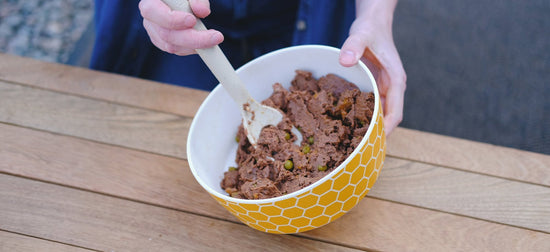There is just about every type of dog food one could possibly imagine available to consumers nowadays. Although, on the whole, this is a good thing, it can lead to confusion and uncertainty as to what might be the best option for your dog.
A lot of dog owners offer a mix of both, possibly because it goes well with their dog or they simply assume they would be getting the best of both worlds. But the large majority will go for one or the other. As deciding on wet or dry food for your dog is one of the first decisions you will have to make as a dog owner once your puppy is old enough to eat dry dog food, we thought we should delve into some of the common questions dog owners have around wet and dry dog food.
The fundamentals of wet and dry dog food
Wet dog food essentially has some form of gravy as a base and contains more water content, hence the name. You will most likely find this food packaged in a can and might even be referred to as Canned (or in our case tetra packed) Dog Food.
Dry dog food on the other hand is mostly in pellet form and is typically referred to as Kibble.
Wet dog food is:
The protein source is also ground up but rather than adding gravy, the mixture is turned into a dough which is then cooked.
Once cooked, the dough is transformed into kibble which is then dried and infused with some fats, vitamins and minerals before packaging.
For dry dog food:
Processed by grinding meat or other protein sources then mixing the grounds with some form of gravy.
The gravy might contain some vitamins or minerals to bolster health.
This mixture is then cooked before adding some preservatives and canning.
From these definitions, you can see that the key differences are mainly in the processing and the moisture content of the food. Both wet and dry dog food contains some moisture content, only that wet dog food has more of it. The percentage of moisture content is usually indicated in the label. As for vitamins, minerals and other nutrients, all these largely depend on the recipe used to prepare the food but generally, there is not much of a difference.
Pros and cons of wet and dry on their own
While there might be no big differences in the nutritional value of both wet and dry dog food, there are a few nuances which you should put into consideration before we delve into details around mixing.
Advantages of wet food
Wet dog food would be an ideal option if your dog does not get adequate water, or if you feel they just don’t simply drink enough based on the activity they complete each day (typically this might be relevant for service or training dogs). The high moisture content would supplement what your dog is drinking to ensure optimal hydration.
Great for young pups
Wet dog food is also a suitable option for young pups who are transitioning from breastfeeding or have not fully developed their teeth. Some pet parents might sprinkle on some dry food but we would suggest mostly sticking with wet food early on, as the moisture is beneficial for puppies.
Great for elderly dogs
Since wet dog food has very intense aromas and flavours, elderly dogs who might be losing their sense of smell are likely to enjoy their meal more compared to dry dog food. For elderly dogs who are eating for survival, but don’t seem to be enjoying it, wet dog food might just titillate their taste buds once again! Also, if your furry friend is ill or has a low appetite, the aroma and flavour of wet dog food might just make the difference.
Low calories
The biggest drawback of dry dog food is perhaps the number of calories it contains. A dog with a ravenous appetite combined with low activity levels could easily become overweight if he or she is solely on dry dog food. Due to the high moisture content in wet dog food, our canine friends get fuller quickly and eat less.

Advantages of dry food
To no surprise, the disadvantages of wet dog food are the advantages dry dog food has to offer.
Shelf life
As we mentioned earlier, wet dog food has a much shorter shelf life compared to dry dog food. This means that wet dog food should not be left for long once opened, as it goes off and exposes you and your dog to harmful bacteria. This could also mean dry dog food is more economical if you are on a budget since you have to stock up less frequently.
Convenience
Dry dog food is also more convenient especially if you are going out on a trip, as you do not have to worry about a fridge for storage.
Dry dog food does not leave as much stain on the teeth compared to wet dog food. If your dog is on canned food, then you might have to establish a proper dental cleaning routine otherwise you will notice a nasty breath or even worse, tooth decay
Benefits of mixing wet and dry dog food
Mixing wet and dry dog food if done properly offers a variety of benefits for you and your furry friend. For one it is an excellent way of adding some variety to your dog’s daily diet and dogs who are susceptible to intolerances may find variety useful in keeping spikes at bay.
But other than that, mixing really allows you to get around the cons of both wet and dry, whilst benefiting from their advantages, such as:
Being able to make sure they get sufficient water intake
You can promote dental health, through the hardness of the kibble
Weight management is made easier. Topping up with one or the other more, is a great way to keep that calorie balance in check depending on how they typically put on weight.
For dogs who are picky eaters, adding a wet dog food topper is a great option as it enhances the aroma and flavour of the meal.
Disadvantage of mixing wet and dry dog food
However, although we can match the pros up, there are some disadvantages of mixing wet and dry.
It can be less cost-effective, due to wet having a shorter shelf life so it might end up being thrown out. Wet is also more expensive than wet, so it will inevitably be more expensive than just doing dry.
It is far less convenient having to make sure you have both wet and dry dog food in stock
Portion control can also be difficult, not to mention it can be inconveniencing for some dog parents especially those with many dogs around the house.
Some dogs also have sensitive stomachs which makes a transition to mixed dog food quite aggravating.
How to portion correctly when mixing wet and dry
Determining the ratio of wet dog food to dry dog food really depends on the needs of your dog. If, for instance, your dog is on dry dog food and is grossly overconsuming calories, you might have a ratio where 40% is dry dog food while 60% is wet dog food (Note that this is ratio is just an example highlighting a decrease in dry dog food to control calorie intake).
It is advisable to consult a vet as they will give the best ratio of dry to wet specific to your dog. If your dog has a sensitive stomach, your vet will also provide guidelines on how to transition to a mixed diet.
Regardless of wet or dry dog food, what matters the most is ensuring your dog gets the nutrients required for optimal health. Mixing both wet and dry is a suitable option with plenty of benefits. It is important to strive for a good balance and proper portion control. Introduce the changes gradually especially if your dog has a sensitive stomach. That being said, dry or wet on their own is also fine as long as they are getting the right nutrients.







